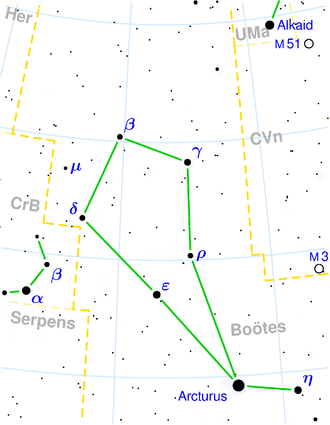NGC 5251
| Galaxie NGC 5251 | |
|---|---|
 | |
| SDSS-Aufnahme | |
| AladinLite | |
| Sternbild | Bärenhüter |
| Position Äquinoktium: J2000.0, Epoche: J2000.0 | |
| Rektaszension | 13h 37m 24,8s[1] |
| Deklination | +27° 25′ 09″[1] |
| Erscheinungsbild | |
| Morphologischer Typ | S0?[1][2] |
| Helligkeit (visuell) | 13,9 mag[2] |
| Helligkeit (B-Band) | 14,8 mag[2] |
| Winkelausdehnung | 0,7′ × 0,7′[2] |
| Flächenhelligkeit | 13,0 mag/arcmin²[2] |
| Physikalische Daten | |
| Rotverschiebung | 0.036655 ±0.000097[1] |
| Radialgeschwindigkeit | 10989 ±29 km/s[1] |
| Hubbledistanz vrad / H0 | (493 ± 35) · 106 Lj (151,0 ± 10,6) Mpc [1] |
| Geschichte | |
| Entdeckung | Wilhelm Herschel |
| Entdeckungsdatum | 11. April 1785 |
| Katalogbezeichnungen | |
| NGC 5251 • PGC 48119 • CGCG 161-090 • MCG +05-32-44 • KUG 1335+276 • GC 3618 • H III 369 • h 1652 • | |
NGC 5251 ist eine 13,9 mag helle linsenförmige Radiogalaxie vom Hubble-Typ S0-a im Sternbild Bärenhüter. Sie ist schätzungsweise 493 Millionen Lichtjahre von der Milchstraße entfernt.
Das Objekt wurde am 11. April 1785 von Wilhelm Herschel mit einem 18,7-Zoll-Spiegelteleskop entdeckt,[3] der sie dabei mit „eF, vS, 240 power left a little doubt“[4] beschrieb.
Weblinks
- NGC 5251. DSO Browser, abgerufen am 8. Februar 2016 (englisch).
- NGC 5251. SIMBAD, abgerufen am 8. Februar 2016 (englisch).
Einzelnachweise
Auf dieser Seite verwendete Medien
Autor/Urheber: Sloan Digital Sky Survey, Lizenz: CC BY 4.0
The sky image is obtained by Sloan Digital Sky Survey, DR14 with SciServer.
Angle of view: 4' × 4' (0.3" per pixel), north is up.
Details on the image processing pipeline: https://www.sdss.org/dr14/imaging/jpg-images-on-skyserver/



